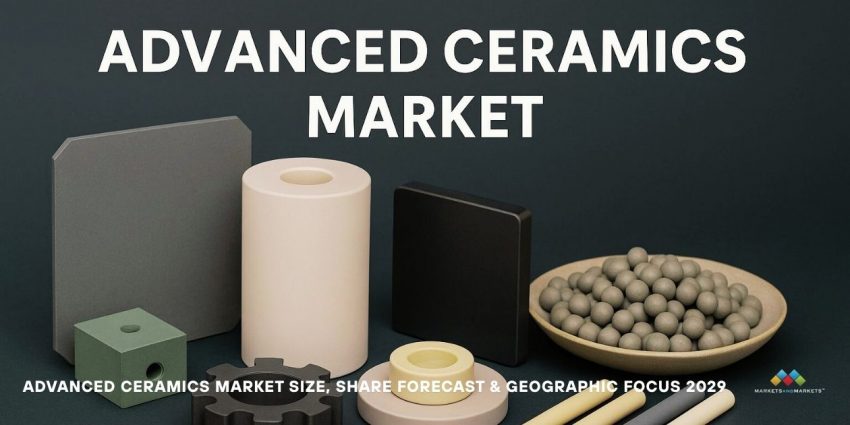In a world driven by high-performance technologies, traditional materials often fall short. This is where advanced ceramics come into play—bringing superior strength, thermal stability, and corrosion resistance to the table. Once confined to niche scientific applications, these engineered materials are now at the heart of sectors like electronics, automotive, medical, defense, and energy.
The global advanced ceramics market is undergoing a significant transformation. With sustainability, miniaturization, and performance at the forefront of industrial demands, manufacturers and end-users alike are leaning into the unmatched capabilities of advanced ceramics. The market is projected to reach USD 16.27 billion by 2029 from USD 12.16 billion in 2024, at a CAGR of 6.0%, driven by technological advancements and rising applications across various sectors.
What Are Advanced Ceramics?
Advanced ceramics are a class of materials that go beyond traditional clay-based ceramics. Made from highly purified and specially formulated raw materials such as alumina, zirconia, silicon carbide, and titanium dioxide, these ceramics offer superior properties:
- High mechanical strength
- Excellent wear and corrosion resistance
- Exceptional thermal and electrical insulation
- Biocompatibility for medical use
- Lightweight with high durability
These properties make advanced ceramics indispensable in critical environments where performance is non-negotiable.
Key Market Drivers
1. Electronics & Semiconductors Boom
The electronics industry is one of the most significant consumers of advanced ceramics. Components such as insulators, capacitors, substrates, and sensors rely heavily on the insulating and heat-resistant properties of these materials. As demand for smaller, faster, and more reliable devices grows, ceramic substrates and heat sinks are becoming essential in high-frequency and power electronics.
2. Rising Electric Vehicle (EV) Adoption
The global shift toward electric mobility is a major growth catalyst. Advanced ceramics are used in EV batteries, sensors, braking systems, and thermal management components. Their ability to withstand high temperatures and mechanical stress makes them ideal for the high-performance demands of EVs.
3. Healthcare Advancements
From orthopedic implants and dental prosthetics to surgical instruments, biocompatible ceramics like zirconia and alumina are revolutionizing healthcare. Their inert nature and compatibility with the human body have made them a preferred choice in critical applications. With healthcare technology constantly evolving, the role of advanced ceramics is only set to expand.
4. Energy & Environmental Applications
Advanced ceramics are increasingly used in renewable energy systems, such as solid oxide fuel cells (SOFCs), solar panels, and wind turbines. Their resistance to extreme temperatures and corrosion makes them ideal for energy-efficient and long-lasting solutions. Additionally, they are also used in filtration systems, helping industries reduce environmental impact.
Market Challenges to Watch
While the outlook is promising, there are hurdles to overcome:
- High production costs due to complex manufacturing processes
- Brittleness in some ceramic compositions under certain mechanical stress
- Limited recyclability, making end-of-life management a concern
However, ongoing R&D is paving the way for innovations that can address these challenges, including the development of tougher ceramics and cost-effective fabrication techniques.
Leading Players in the Market
The market is fairly consolidated, with a few key players driving innovation:
- Kyocera Corporation – Known for its electronic components and ceramic-based solutions.
- 3M – Offers ceramics for filtration, electronics, and advanced coatings.
- CoorsTek Inc. – A major player in industrial ceramics across multiple applications.
- Morgan Advanced Materials – Specializes in engineered ceramics for energy, defense, and healthcare sectors.
- CeramTec GmbH – Leading in medical and industrial ceramic components.
Regional Landscape
Asia Pacific holds the lion’s share of the market, led by countries like China, Japan, and South Korea. Rapid industrialization, growing electronics manufacturing, and government investments in healthcare and EV infrastructure are driving growth in this region. North America and Europe follow closely, with a strong focus on innovation and environmental compliance.
Explore the full report – Download the PDF brochure now.
The advanced ceramics market is no longer a quiet niche. It’s becoming a vital backbone for industries requiring materials that outperform metals and polymers. Whether it’s for boosting energy efficiency, ensuring medical safety, or enabling next-gen electronics, advanced ceramics are powering the technologies of tomorrow.

